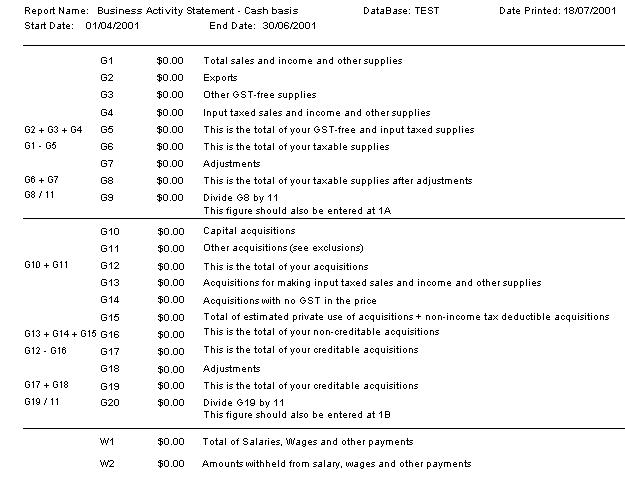Chapter 4 - How to do your BAS
Introduction
Doing your BAS is a relatively simple exercise, because you have already told ezBooks
all the information it requires to classify the various receipts and payments by
their GST type. ezBooks will provide you with figures for GST and any wage deductions
if you have entered them. It will not provide figures for other forms of tax such
as car tax, fringe benefits tax or tax deductions from payments to contractors.
The entire design philosophy of ezBooks is not to overload you with technology so
we took the view most of our users would not want to be logging onto the ATO via the
internet and making electronic returns. ezBooks expects you will still use the paper form
that the ATO provides.
In this section we will tell you:
How to produce the printed BAS report (5 mins)
You access the BAS report through the top menu bar:

Click on Reports > Business Activity Statement:

The only tricky part of the procedure is to remember that the default dates on this
GUI are set to your previous quarter end. If you are in July, they will run from the
previous 1 April
to 30 June. This is normally correct (you do your BAS in the first few weeks of the new
quarter). However, if you want to estimate your GST liabilities while you are still in
the current quarter you will have to change the dates appropriately. You can do this in
the usual way.
Now click Print and a small report progress GUI appears prior to the print
viewer displaying the BAS report. We produce a fragment of that report below:

The box numbers down the left hand side correspond to the box numbers shown on your ATO
BAS form. As you can see all the dollar figures are zeros. This is for two reasons.
Firstly we have produced
a BAS report for the previous quarter and there are no posting in that quarter - we only started
this test database recently. However, equally important, the Test database is using as cash basis of
accounting and our one sale to Michael Cain is still unpaid! This is how you defer paying
tax with a cash basis as when compared with an accruals basis.
Looking down the form you will see it is broken into three sections. The first analyses the
income of your business, the second analyses the expenses of your business and the final
section analyses any wage deductions you may have made. Naturally, if you are not using the
integrated payroll package these last figures will be blank.
Click the print icon and then Exit and return to the main ezBooks screen. You have finished
the extraction of the BAS report.
What to do next (5 mins)
You should sit down with your actual BAS form and your printed BAS report.
The report has some notes at it foot:

There is only so much a computer can do. There may be some adjustments you have to make.
You should read the notes which point out that if you have had some partial
private use you should make an adjustment.
If you are using the accruals method, you may also find that it is
difficult to monitor the GST implications of regular monthly payments taken from
your bank account. Your insurance premiums may be taken directly from your account
and there may be a GST element in them. Unlike cash basis users (who are compelled to
characterise any payment from their bank account for GST purposes at the time it is entered)
users of the accruals method control their GST through their sales and purchase day books.
You will only become aware of this type of deduction when you do your
bank reconciliation. If you want to
fully recover GST make sure you then enter them via the purchase screen and use
the Paid Now facility.
An alternate method is to keep a note (or the documents from the insurance company) of the
amounts and tax involved and to make an adjustment to the figures prior to
completing your return. If you hand write a note of these matters on the BAS
report and keep the BAS report with a copy of
your return you will always be well placed to explain your actions.




